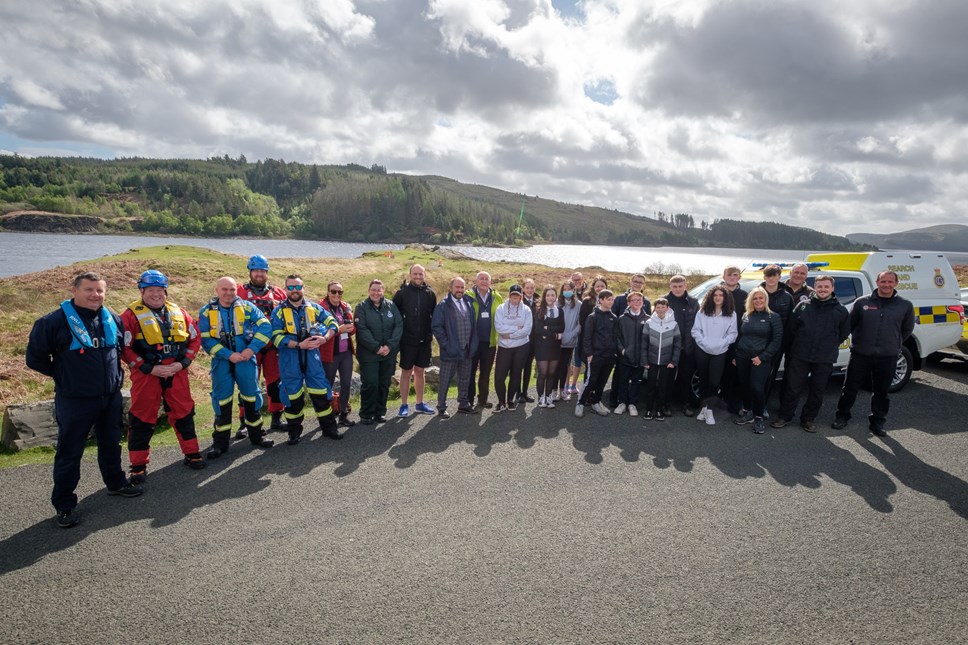
Loch Doon hosts Scotland's first outdoor water safety awareness training
Young people from Doon Academy have taken part in Scotland’s first outdoor water safety awareness course at Loch Doon in East Ayrshire.
Living in a rural area means that local children and young people have access to rivers, reservoirs and lochs and playing in or near water can be very tempting, especially during the summer months. Across Scotland, Scottish Fire and Rescue regularly respond to emergency calls from people who have witnessed someone getting into difficulty in open water and tragically, 96 people on average drown each year.
To ensure our children and young people understand the dangers of open water, the Council’s Health and Safety section joined forces with Scottish Fire and Rescue, RNLI, Police Scotland, the Maritime and Coastguard Agency, Loch Doon Rangers and the Scottish Ambulance Service to create an innovative water safety awareness course.
Doon Academy and Bellsbank and Dalmellington Primary Schools, will attend the training sessions where they will learn about the hidden hazards within and around the water and how to correctly use the life-saving equipment strategically positioned around the loch. They will receive essential lifesaving skills training including CPR awareness and defib training and will be taught how to float in the water, should they find themselves in danger. They will also learn invaluable information about cold-water shock, which is one of the main causes of drowning in Scotland.
Local elected members for Doon Valley, Councillors Drew Filson and Elaine Stewart attended the first training session with the young people from Doon Academy and Head Teacher Kenneth Reilly.
Councillor Drew Filson said: “The new water safety awareness training is really innovative and will contribute to ensuring that anyone coming along to enjoy what is a true jewel in the crown of East Ayrshire in terms of its natural beauty can do so as safely as possible. The recent tragedy at Loch Doon shows just how dangerous the water can be. The loch is deep, very cold at all times of the year and has strong currents, which can result in someone quickly getting into difficulty. It is important that as many people as possible understand the dangers, particularly our children and young people.
“I would like to thank all those who have been involved in making Loch Doon a safer place for everyone to enjoy.”
David Doran, Health and Safety Manager at East Ayrshire Council said: “While we are lucky in East Ayrshire to be able to enjoy beautiful river side and loch walks, open water is incredibly dangerous and we have to ensure that we treat open water with the respect it deserves.
“The water safety awareness course that the Health and Safety team has developed with our partners is innovative and I have no doubt, will ensure that our children and young people approach open water cautiously, understanding the significant dangers it can pose.”
Last year, a Portsafe public access rescue system was installed at Loch Doon with funding from local landowner Drax and Scottish Fire and Rescue. The Portsafe system is a 17-metre extendable pole that can be used from the shore. The emergency services must be contacted for a code to access the equipment and are therefore immediately alerted to any drowning incident. A community access defibrillator has also been installed at the Roundhouse Café with funding raised by the local community.
Ian McMeekin, Local Senior Officer for the Scottish Fire and Rescue Service in East, North and South Ayrshire said: “This is a great initiative to educate and inform our communities on water safety. We will continue to work with all of our partners across Ayrshire to support measures to keep people safe and continue to raise awareness of the dangers of water.”
He said: “Safety is our top priority. Recently, we have seen several incidents in Ayrshire and across Scotland that have sadly shown how important it is to stay safe in and around Scotland’s waters.
"Although it might seem warm enough, open water can be very cold and cause cold water shock which can affect anyone of any age, fitness or experience levels. It’s also often impossible to know what hazards lie below the surface of the water.
“Knowing what to do in the event of an emergency, and having lifesaving equipment to hand, can make a big difference before locally trained crews with specialist resources including rescue boats arrive on scene. We are also delighted in supporting the initiative with lifesaving out of hospital cardiac arrest defibrillator training.”

